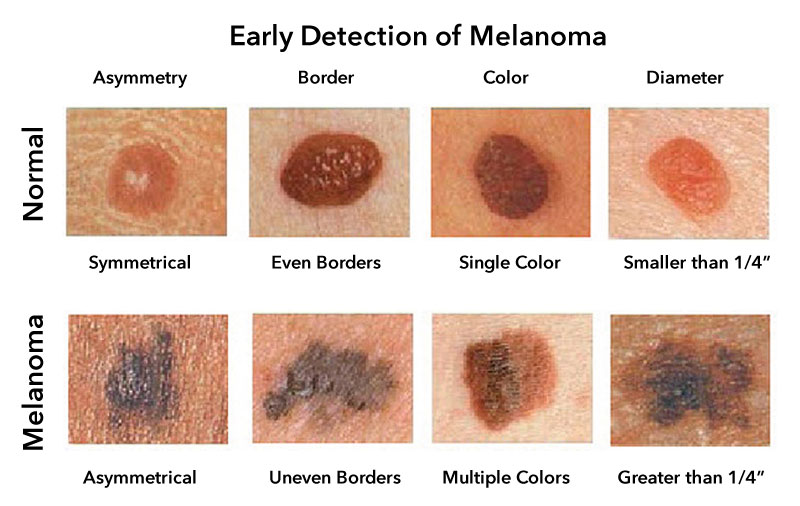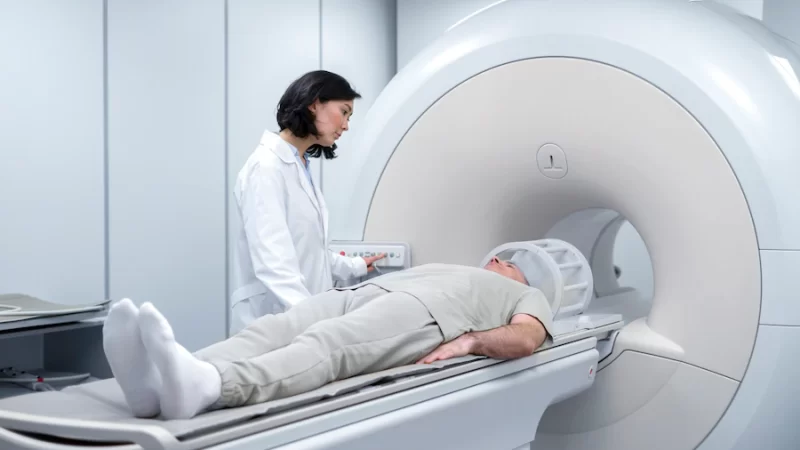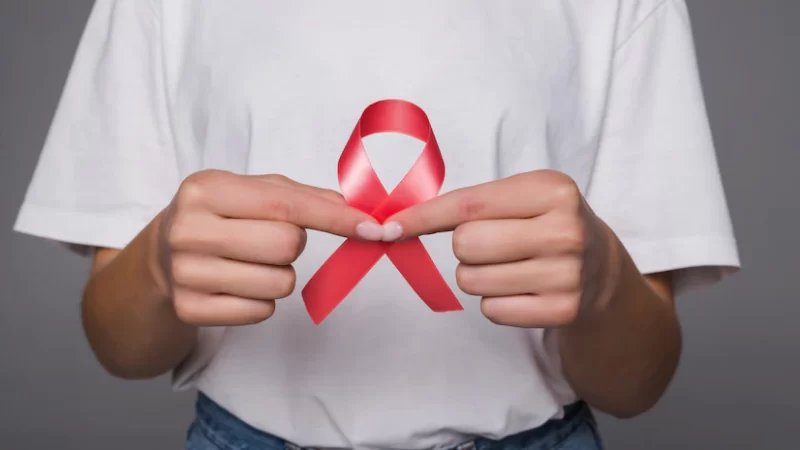Melanoma Skin Cancer, Types, Stages, Signs, Symptoms & Treatment

Melanoma, also known as malignant melanoma and cutaneous melanoma, is a type of skin cancer that develops anywhere on the skin. Melanoma occurs when melanocytes (cells that produce a brown pigment called melanin) responsible for the tan or brown colour of the skin, mutates and start growing uncontrollably.
It may develop anywhere on the skin but generally, it starts affecting the chest and back, in case of men and legs, in case of women. Other common areas include the face and neck. It may also develop in the eyes, mouth, anal area and genitals but chances of melanoma occurring here are much less than on the skin. Likewise, people with a darker skin tone have a lesser chance of developing melanoma.
Although lesser in occurrence compared to other types of skin cancers, it is more hazardous as it easily spreads to other parts of the body if not diagnosed and treated early.
Yashoda Hospital & Research Centre, Nehru Nagar, Ghaziabad is committed to sharing needful information that will help you to know about the types of melanoma, its risk factors, signs and symptoms, diagnostic procedures, stages as well as treatment.
Melanoma Skin Cancer Types
Melanoma can be categorized into 4 types
Superficial Spreading Melanoma
It is the most common type of melanoma that generally appears on the torso or limbs. Here, the cells have a slow growth rate at first which starts escalating rapidly once it spreads across the surface of the skin.
Nodular Melanoma
It is the most aggressive type of melanoma that may be reddish or blue-black in color; it generally grows faster than other melanomas. It is the second most common type of melanoma that may appear on the areas of the torso, head or neck.
Lentigo Maligna Melanoma
It generally occurs on parts of the body that have been exposed to the sun excessively over several years, such as the face. It is found more in older adults and is less common. Its representation may be in the form of a stain on the skin known as Hutchinson’s freckle or lentigo maligna. It is less hazardous than other types and generally grows slowly.
Acral Lentiginous Melanoma
It may develop on the soles of feet, palms of hands or beneath the nails and is the rarest type of melanoma.
Although other types of melanoma do not develop in people with darker skin usually, acral lentiginous melanoma is the most common in people with a darker skin tone.
Stages and Grades of Melanoma
To determine the stage of cancer, doctors may use the system of TNM. In the TNM structure, T stands for the thickness of the original tumor and whether it has ulcerated while N stands for cancer that has spread beyond the original tumor to the nearby lymph nodes and M indicates if cancer has spread to other organs such as lungs or brain or to other distant lymph nodes.
After the TNM system is categorized and identified, the doctors will identify the stage in which cancer lies.
Early-Stage Melanoma
Stage 0- This stage is also known as melanoma in situ as it is present only in the outermost layer of the skin and has not yet advanced deeper.
Stage I- Cancer in this stage has advanced to the next layer of the skin from the outermost layer and is smaller than 1mm in Breslow Depth. Cancer in this stage may or may not have been ulcerated.
Intermediate or High-Risk Melanoma
Stage II- The tumors in this stage advance deeper than 1mm into the layer of the skin but they may or may not be ulcerated. The risk of spreading to other parts is high and so doctors may ask you to have a sentinel lymph node biopsy (SLNB) to examine if melanoma cells have spread to the local lymph nodes.
Advanced Melanoma
Stage III- In this stage, the tumor has spread to the local lymph nodes. Sometimes, the tumor may not have reached the local lymph nodes but may have reached the lymph vessels more than 2 cm away from the primary tumor.
Stage IV– In this stage, cancer has advanced to other parts of the body such as lymph nodes, brain, lungs, liver, bone and the gastrointestinal tract. To determine the extent and degree of the advancement of melanoma, doctors may examine the site of the distant tumors and also the level of elevated serum lactate dehydrogenase (LDH). (LDH is an enzyme that converts sugar into energy but it may be harmful if it is found more in blood or body fluids.)
Signs & Symptoms of Melanoma Skin Cancer
Any new spot on the body or an evolving spot unusual in shape, size, or color may be the most essential warning sign of melanoma. In case, a spot looks completely different from all other spots on your body, known as ugly duckling sign, consult a dermatologist.
You may also follow the ABCDE rule that helps in guiding you about the signs of melanoma. The ABCDE rule is described as follows:
A for Asymmetry: Spots or moles on the body do not match the others.
B for Border: The border or the edge of the spot or mole is uneven, rough, and vague.
C for Color: The color of the spot may have different patches of red, blue, pink, or white and even may have shades of brown or black.
D for Diameter: Spots larger than 6 millimeters across (approximately one-fourth of an inch or the size of the pencil eraser) may also be a sign of developing melanoma.
E for Evolving: Any change in size, shape or color of the spot or mole.
Consult your dermatologist if you are not sure of any mole as the difference between melanoma and an ordinary mole may be hard to distinguish.
Risk Factors of Melanoma Skin Cancer
There are various factors that may play a role in increasing the risk of melanoma skin cancer. Some of them are as follows:
- Excessive exposure to the sun which may lead to the development of freckles on the skin.
- Persons having a high number of moles or having a high number of unusual moles on their bodies.
- Presence of age spots or liver spots also known as actinic lentigines.
- Presence of a giant brown birthmark known as congenital melanocytic nevi.
- Persons with lighter eyes and light or red hair.
- Exposure to excessive and irregular sunlight which may cause sunburns is also another factor.
- Organ transplant in the past.
- Any record of family or personal history of having melanoma.
Need to consult a dermatologist in Delhi NCR?
Yashoda Hospital & Research Centre, Nehru Nagar, Ghaziabad provides you with world-class and technologically advanced facilities. Our dedicated specialists have years of experience and expertise. Dr. Rajeev Jain, one of the senior-most dermatologists and venereologists at Yashoda, has an experience of more than 18 years in dealing with different kinds of skin conditions and diseases. Dr. Anup Kumar Tiwary is a highly proficient and skilled consultant in the field of Dermatology and Cosmetology. He is well-trained in cosmetic procedures such as PRP therapy, botulinum toxins and lasers for various skin and hair problems including mole and scar treatment and removal.
Diagnostic Procedures
The tests and procedures that are used to diagnose melanoma at Yashoda Superspeciality Hospital & Cancer Institute, Sanjay Nagar, Ghaziabad are illustrated as below:
Physical exam– This includes examining your skin to see if there is any sign that may be a symptom of melanoma. Your doctor may inquire about your health history.
Removing a sample of tissue for testing (biopsy) – On suspecting that a skin lesion is a melanoma, your doctor may remove the sample of the skin to send it to a lab for its test and examination.
After you are diagnosed with melanoma, the doctor will examine the extent to which melanoma has spread. This process is known as staging. How much cancer is in the body and how dangerous it can be is determined by the stage of cancer.
Melanoma skin cancer treatment and its types
The size and stage of melanoma skin cancer, your health, and your personal choices will determine which type of treatment will be best for you. The ex-Army & Tata Memorial trained team of oncologists at Yashoda Superspeciality Hospital & Cancer Institute, Sanjay Nagar, Ghaziabad, use technologically advanced equipment and newly researched methods to treat Melanoma Skin Cancer.
Treatment for Early-Stage Melanoma
Early-stage melanoma is treated by surgery in which the surgeon will eliminate the cancer as well as a part of the normal skin including the layer of tissue under the skin. The surgeon may also remove a very thin melanoma entirely during the biopsy after which you may not require any treatment.
Treatment for Melanoma that has spread beyond the skin
Surgery- Melanoma that has spread to nearby lymph nodes is treated by removing the affected nodes. The surgeon may also recommend additional treatments before or after the surgery if needed.
Immunotherapy- It is a drug treatment that enhances the immune system to fight cancer. It may be injected directly into the melanoma when the cancer cannot be removed completely with surgery. That is why, this therapy is generally recommended after surgery when the melanoma has spread to the lymph nodes or to other parts of the body.
Targeted Therapy- In this treatment, a drug is given to target the specific weaknesses present within the cancer cells and thus destroying them. Tests may be done on the cells from your melanoma to determine whether the targeted therapy is effective against your cancer or not.
Radiation Therapy– In this treatment, high doses of energy beams are targeted at the cancer cells to destroy them. This therapy may be helpful in treating those melanomas that cannot be removed completely with surgery. It also helps in relieving symptoms if the melanoma has spread to other parts of the body.
Chemotherapy-In this treatment, a drug is used to destroy cancer cells. This drug has to travel throughout the body and so it may be given intravenously or in pill form or both. Chemotherapy may be also given in a procedure known as isolated limb perfusion in which the drug may be given in a vein of the arm or leg. During this procedure, the blood in the arm or leg is restricted to travel to other parts of your body for a short period of time such that the chemotherapy drug travels directly to the part having melanoma and not affecting other parts of your body.
Looking for a Specialist/Doctors for Melanoma Cancer in Delhi NCR?
Yashoda Superspeciality Hospital & Cancer Institute, Sanjay Nagar, Ghaziabad, provides you with advanced facilities fully updated with all the technological equipment required for the treatment of cancer. At Yashoda, you may opt for specialists for all types of cancers. We have specialists in medical oncology, dermatology as well as surgical oncology who will help you to have the best treatment. All therapies are offered under the same roof.
Specialists at Yashoda Superspeciality Hospital & Cancer Institute, Sanjay Nagar, Ghaziabad
Yashoda Superspeciality Hospital & Cancer Institute has certified specialists who are well experienced. Dr.(Brig.) Arvind Kumar Tyagi, one of the senior-most surgical oncologists and the Director of Surgical Oncology at Yashoda, has experience of more than 30 years. He has served in the armed forces and also has received various awards with many publications to his credit.
Dr. (Maj. Gen.) B. N. Kapur, the Director of Medical Oncology at Yashoda, also has rich experience and has served in the army for more than 36 years. He has received many awards in the fields of hematology and oncology. He is skilled in the treatment of solid organ cancer using the latest evidence-based therapies.
If you are facing any signs or symptoms mentioned above book an appointment at Yashoda Hospital and get the best treatment.




